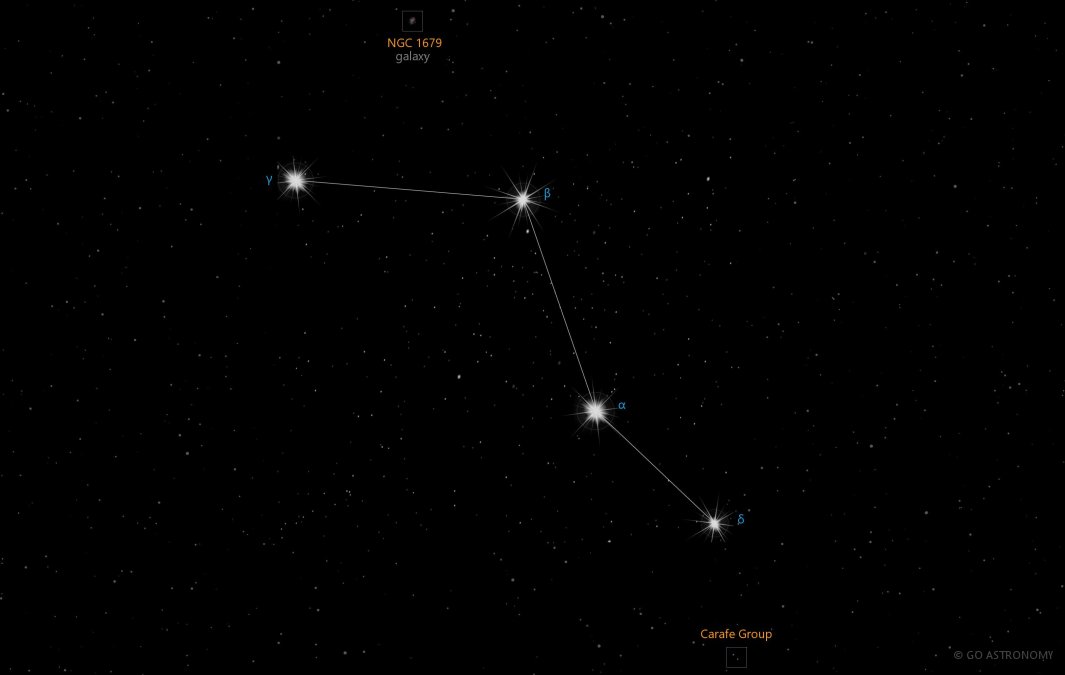Caelum, the Chisel (Cae)
(SEE-lum)
The Southern constellation of Caelum, the Chisel, is best viewed in Winter during the month of January.
Caelum is the 81st largest constellation. It's brightest star is Alpha Caeli at magnitude 4.45. The boundary of the Caelum constellation contains 1 stars that host known exoplanets.
- Pronunciation:
- SEE-lum
- Meaning:
- Chisel
- Genitive:
- Cali
- Abbreviation:
- Cae
- Constellation Family:
- LaCaille
- Hemisphere:
- Southern
- Quadrant:
- SQ1
- Visibility:
- 40° N - 90° S
- Best viewing month*:
- January
- Area:
- 125 sq. degrees
- Size:
- 81st largest
- Right Ascension (avg):
- 4h 43m
- Declination (avg):
- -39°
- Brightest star:
- Alpha Caeli (4.45)
- Stars with planets:
- 1
- Messier objects:
- |
- Caldwell objects:
- |
Brightest Stars in Caelum
The 10 brightest stars in the constellation Caelum by magnitude.
- Star
- Magnitude
- Spectral class
- Alpha Caeli (α Cae)
- 4.44
- F2IV
- Gamma Caeli (γ1 Cae)
- 4.55
- K2III
- Beta Caeli (β Cae)
- 5.04
- F3V
- Delta Caeli (δ Cae)
- 5.07
- B2IV-V
- HD 30080
- 5.66
- K3III
- HD 31093
- 5.82
- A2/A3V
- HD 32515
- 5.92
- K2III
- HD 32453
- 6.02
- G8III
- HD 30432
- 6.04
- K1III
- Nu Caeli (ν Cae)
- 6.06
- F1III-IV
Galaxies in Caelum
The most notable galaxies in the constellation Caelum. Also see all galaxies.
The Sculptor's Chisel of the Heavens
Caelum, often depicted as an engraver's chisel, is a small and faint constellation in the southern sky. Despite its unassuming nature, it is rich in deep-sky objects and astronomical history. While it may not be the first pick for amateur skywatchers, Caelum is an excellent region for those with a deeper interest in astronomy and the mythology of the stars.
Historical and Mythological Background
Caelum is one of the fourteen constellations created by the French astronomer Nicolas Louis de Lacaille during his trip to South Africa in the mid-18th century. Unlike most constellations, which are typically based on mythical creatures or figures, Caelum represents a chisel, an instrument used by sculptors and engravers. Lacaille, eager to modernize the sky, named many constellations after scientific and artistic instruments. Caelum is a testament to this dedication, symbolizing the tools that artisans use to shape their works.
Location and Key Features
Caelum is located in the first quadrant of the Southern Hemisphere (SQ1) and can be seen at latitudes between +40? and -90?. Despite being the eighth smallest constellation in the sky, covering an area of only 125 square degrees, it is surrounded by more prominent constellations such as Eridanus, Columba, Lepus, and Dorado, which can aid in its location.
Unlike many other constellations, Caelum does not have any stars brighter than fourth magnitude, making it quite faint and challenging to see, especially from light-polluted areas. Its brightest star, Alpha Caeli, is a double star system with a combined apparent magnitude of 4.45. The primary component is a white main sequence star similar to our Sun, while the secondary is a much fainter red dwarf.
Deep Sky Objects
While the constellation of Caelum is devoid of bright stars and Messier objects, it is home to a few noteworthy deep-sky objects. One of them is the spiral galaxy NGC 1679. This barred spiral galaxy, of magnitude 13.6, is observable only under dark skies with a sizable telescope.
Observing Caelum
Given its faint stars and southern declination, Caelum is not an easy constellation to observe from the northern hemisphere. However, from southern latitudes, it is visible in the summer months. Once located, the most interesting feature to observe within Caelum is arguably its brightest star, Alpha Caeli. Despite its apparent magnitude of 4.45, it can provide a fascinating view with a small telescope, revealing its binary nature.
The deep-sky object NGC 1679, albeit faint and requiring a sizable telescope, provides an exciting challenge for seasoned observers or astrophotographers. If the sky is dark enough, it could be an intriguing target.
* Constellation shown for northen hemisphere skies. For the southern hemisphere, constellations appear rotated 180 degrees (upside-down and left-right reversed) from what is shown. Remember that seasons are reversed too - summer in northern latitudes is winter in southern latitudes.
** Circumpolar constellations are visible year-round in the hemisphere listed (and not at all in the opposite hemisphere).





